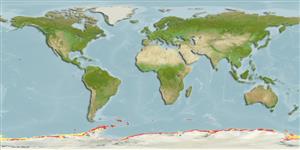>
Perciformes/Notothenioidei (Icefishes) >
Nototheniidae (Cod icefishes) > Trematominae
Etymology: Trematomus: Greek, trematos = hole + Greek, tomo = section, cut (Ref. 45335); hansoni: Species name hansoni honors Nicolai Hanson, biologist of the Southern Cross Expedition..
More on author: Boulenger.
Issue
The genus Pseudotrematomus is a synonym of Trematomus, which is confirmed by a molecular study to be published (J.-C. Hureau, pers. comm. 08 Jun. 2010).
Environment: milieu / climate zone / depth range / distribution range
Écologie
marin démersal; profondeur 6 - 549 m (Ref. 11892). Polar; 53°S - 78°S
Southern Ocean: South Orkneys, South Georgia and South Shetland islands. Ross, Davis and Weddell seas, South Victoria, Adelie, Queen Mary and Princess Ragnhild Coasts.
Taille / Poids / Âge
Maturity: Lm ? range ? - ? cm
Max length : 45.5 cm TL mâle / non sexé; (Ref. 58849); common length : 25.0 cm TL mâle / non sexé; (Ref. 2121)
Épines dorsales (Total): 5 - 8; Rayons mous dorsaux (Total): 36-41; Rayons mous anaux: 33 - 37. Body brownish, large dark spots or cross bars on body. Head often spotted, fins barred with series of dark spots (Ref. 11892).
Adults feed on small fishes, krill and other euphausiids, polychaetes, copepods, amphipods, isopods and small gastropods. Mature individuals spawn once a year (Ref. 1071).
Dewitt, H.H., P.C. Heemstra and O. Gon, 1990. Nototheniidae. p. 279-331. In O. Gon and P.C. Heemstra (eds.) Fishes of the Southern Ocean. J.L.B. Smith Institute of Ichthyology, Grahamstown, South Africa. (Ref. 5179)
Statut dans la liste rouge de l'IUCN (Ref. 130435)
Menace pour l'homme
Harmless
Utilisations par l'homme
Plus d'informations
CollaborateursImagesStamps, Coins Misc.SonsCiguateraVitesseType de nageSurface branchialeOtolithesCerveauxVision
Outils
Articles particuliers
Télécharger en XML
Sources Internet
Estimates based on models
Preferred temperature (Ref.
123201): -1.8 - 0.5, mean -1.1 °C (based on 348 cells).
Phylogenetic diversity index (Ref.
82804): PD
50 = 0.5005 [Uniqueness, from 0.5 = low to 2.0 = high].
Bayesian length-weight: a=0.00427 (0.00275 - 0.00661), b=3.29 (3.16 - 3.42), in cm total length, based on LWR estimates for this species & Genus-body shape (Ref.
93245).
Niveau trophique (Ref.
69278): 3.4 ±0.54 se; based on food items.
Résilience (Ref.
120179): Milieu, temps minimum de doublement de population : 1,4 à 4,4 années (K=0.22-0.23; Fec = 5,851-12,000).
Fishing Vulnerability (Ref.
59153): High vulnerability (55 of 100).
Climate Vulnerability (Ref.
125649): High vulnerability (57 of 100).
Nutrients (Ref.
124155): Calcium = 22.8 [13.3, 57.4] mg/100g; Iron = 0.459 [0.186, 0.931] mg/100g; Protein = 17.1 [16.1, 18.2] %; Omega3 = 0.352 [0.194, 0.626] g/100g; Selenium = 15.5 [6.3, 37.8] μg/100g; VitaminA = 23 [5, 116] μg/100g; Zinc = 0.487 [0.313, 0.759] mg/100g (wet weight); based on
nutrient studies. 